Sloths, those slow-moving, tree-dwelling mammals, have captivated the hearts of many with their unique lifestyle and adorable demeanor. Beyond their leisurely pace, there’s much more to these creatures. Here are the top 10 fascinating facts about sloths that showcase their remarkable traits and behaviors.
 Pin
Pin Image by nuraghies on Freepik
Table of Contents
1. Incredible Slowness
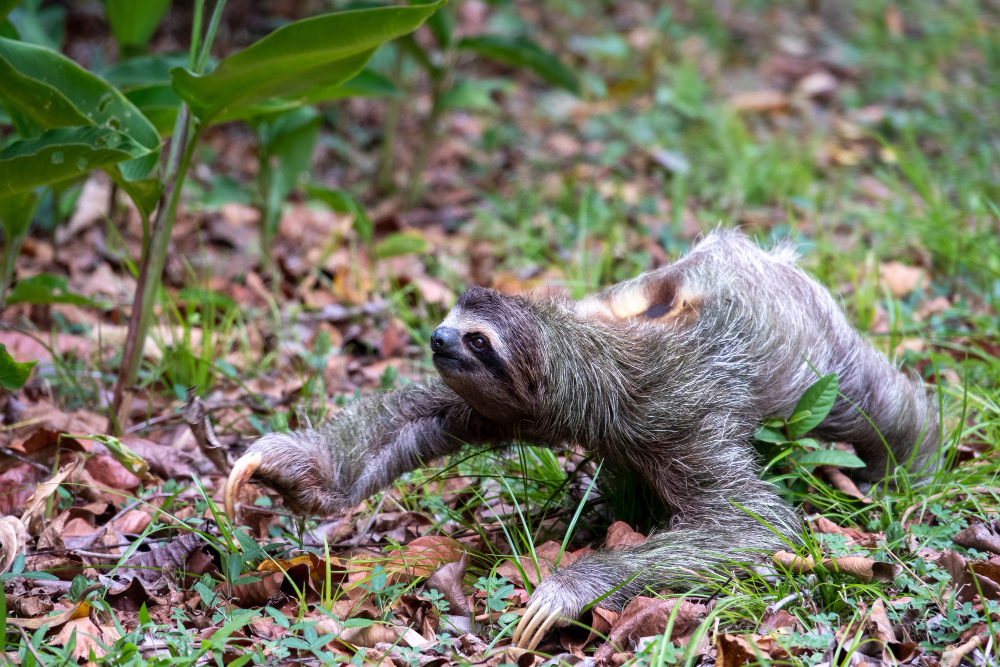 Pin
Pin Image by wirestock on Freepik
One of the most striking facts about sloths is their incredibly slow movement. This leisurely pace is due to their low metabolic rate, which conserves energy, allowing them to survive on a diet primarily of leaves.
In the realm of the animal kingdom, sloths stand out for a rather unique and fascinating trait: their incredible slowness. This distinctive characteristic is not merely a curious quirk but a masterful adaptation to life in the treetops of Central and South American rainforests. The secret behind their unhurried lifestyle lies in their extraordinarily low metabolic rate, one of the slowest among mammals. This slow metabolism is perfectly suited to their diet, which consists mainly of leaves.
Leaves, although plentiful, provide very little energy and nutrients. To cope with this dietary constraint, sloths have evolved to do almost everything at a leisurely pace. Their low metabolic rate means that they require less energy to survive than other animals. By moving slowly, they conserve energy, making the most of their limited and low-nutrition diet. This slow pace also has the added benefit of making them less noticeable to predators such as jaguars, snakes, and eagles. In a sense, moving slowly is both a survival strategy and camouflage, allowing sloths to blend in with the canopy and appear almost indistinguishable from the branches and leaves surrounding them.
This remarkable slowness is accompanied by an exceptional ability to hang from tree branches thanks to their strong claws, which further reduces their energy expenditure. Sloths spend most of their lives hanging upside down, a lifestyle facilitated by their unique physical adaptations. These adaptations include a specialized circulatory system and the ability to rotate their heads up to 270 degrees, which compensates for their sluggish pace by allowing them to keep a lookout for predators and food without the need for rapid movement.
The incredible slowness of sloths is a testament to the marvels of evolution, illustrating how organisms can thrive by perfectly adapting to their environment and the resources available to them. Through their leisurely pace, slow metabolism, and dietary choices, sloths have carved out a niche in the ecosystem, showing that in the race of life, sometimes the slowest participants are perfectly equipped to endure and flourish.
2. Tree-Dwelling Lifestyle
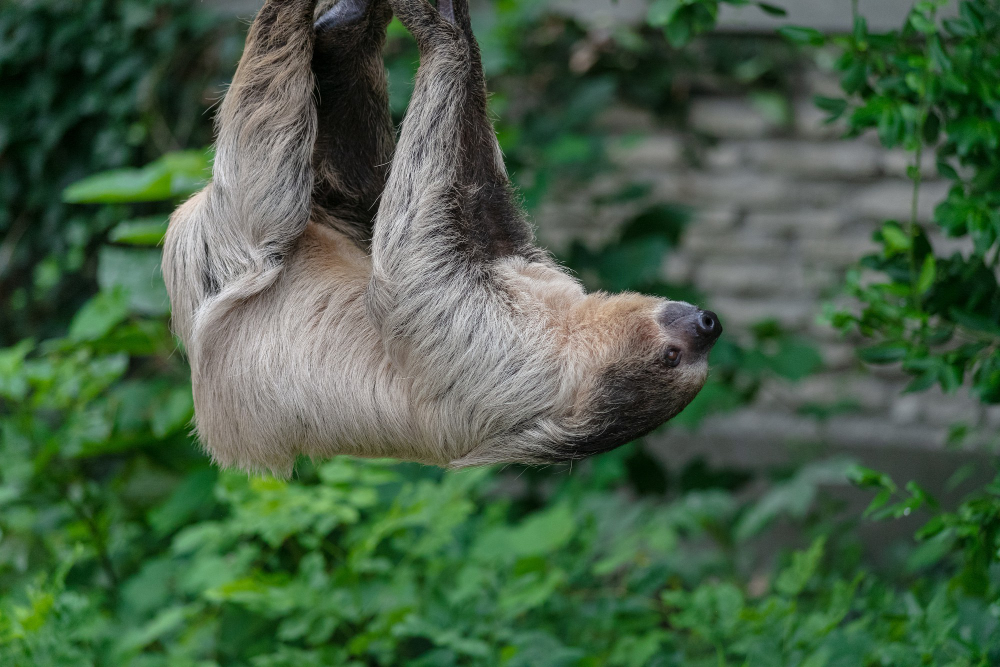 Pin
Pin Image by wirestock on Freepik
Sloths spend most of their lives hanging from trees. Their strong claws are perfectly adapted for this arboreal existence, enabling them to sleep, eat, and even give birth while suspended in the air.
Sloths have truly mastered the art of a tree-dwelling lifestyle, embodying a fascinating example of adaptation and survival in the lush canopies of their forest habitats. These creatures spend the vast majority of their existence in a state of serene suspension, gracefully hanging from the branches that both cradle and sustain them. Central to this elevated existence are their remarkable claws, which are far more than mere appendages. These strong, curved claws are marvels of natural design, perfectly adapted to offer sloths a grip that is as steadfast as it is gentle, allowing them to anchor themselves to the tree branches with an effortless grace.
This aerial life is comprehensive and complete. Sloths are not simply hanging around; they are actively engaging with their environment from an elevated perspective. These claws enable them to sleep amid the whispering leaves, partake in the bounty of the trees by eating the surrounding foliage, and even participate in the circle of life by giving birth while suspended in the air. Each of these activities is conducted with a slow, deliberate grace that is both captivating and uniquely their own.
This arboreal existence is not merely a matter of preference but a profound adaptation that speaks to the sloth’s evolutionary journey. Their bodies are so intimately intertwined with their tree-filled homes that even their fur has adapted to blend seamlessly into the canopy, hosting a variety of symbiotic organisms that further camouflage and connect them to their leafy abode.
In essence, the sloth’s tree-dwelling lifestyle is a testament to the incredible adaptability and resilience of nature. Through their strong claws and peaceful demeanor, sloths have carved out a niche that allows them to thrive in the treetops, demonstrating a perfect harmony between an organism and its environment. This unique mode of existence not only highlights the marvels of evolutionary adaptation but also underscores the intricate balance of ecosystems where such creatures play an integral role.
3. Unique Digestive System
 Pin
Pin Image by brgfx on Freepik
Their diet of leaves, which are not highly nutritious and hard to digest, requires a specialized stomach. Sloths have a multi-chambered stomach that slowly breaks down the tough leaves, a process that can take up to a month.
Sloths, those captivating and leisurely creatures of the canopy, possess a remarkably unique digestive system that is perfectly tailored to their slow-paced lifestyle and specialized dietary requirements. Thriving on a diet primarily composed of leaves, which are notably low in nutrients and difficult for many animals to digest, sloths have evolved an extraordinary adaptation to navigate this challenge. Their multi-chambered stomach is a marvel of nature, intricately designed to efficiently process the tough, fibrous plant material that makes up the bulk of their diet.
This sophisticated stomach is divided into several compartments, each playing a vital role in the breakdown of cellulose and other complex compounds found in leaves. The process is incredibly slow, mirroring the sloth’s overall languid approach to life, and can take up a staggering month to complete. During this prolonged digestion period, symbiotic bacteria residing in the stomach chambers work tirelessly to ferment the leafy matter, gradually extracting the scant but sufficient nutrients the sloth needs to sustain its low-energy lifestyle.
What’s fascinating about this slow digestive process is how it aligns with the sloth’s metabolism and energy conservation strategy. By taking their time to extract every possible nutrient from their hard-to-digest meals, sloths minimize their need for frequent feeding. This not only allows them to remain motionless and camouflaged amidst the treetops, avoiding predation, but it also conserves energy, since foraging for food and moving from one place to another demands more resources.
The sloth’s unique digestive system contributes to their overall ecological role within their habitat. As they slowly process their leafy diet, they contribute to the nutrient cycle within the forest, supporting the ecosystem’s health and diversity. This special adaptation emphasizes the extraordinary lengths to which evolution can go, crafting unique solutions to dietary challenges and illustrating the intricate connections between organism and environment.
In essence, the sloth’s multi-chambered stomach is more than just a biological curiosity; it is a testament to the incredible adaptability and resilience of nature, showcasing how life can flourish in even the most unlikely circumstances by turning apparent limitations into survival advantages.
4. Swimming Skills (Video)
Despite their sluggishness on land, sloths are surprisingly good swimmers. They use their long arms to paddle through water and can hold their breath for up to 40 minutes, allowing them to cross rivers and avoid predators.
Despite their reputation for being slow-moving creatures that seem to be in a perpetual state of leisurely lounging among the treetops, sloths possess an unexpectedly adept skill that contradicts their terrestrial sluggishness: they are excellent swimmers. This fascinating aspect of their nature comes as a surprise to many, given their seemingly lethargic lifestyle on land.
Sloths employ their impressively long arms to navigate the water, using them to paddle with a grace and efficiency that one would not anticipate given their clumsy movements on solid ground. This transformation from slow land-dwellers to agile swimmers is nothing short of remarkable, shedding light on the hidden complexities of their behavior and survival strategies.
One of the most astonishing feats of their aquatic ability is their capacity to hold their breath underwater for up to 40 minutes. This incredible adaptation allows sloths not only to traverse rivers and bodies of water with ease but also to evade potential threats lurking on land. Predators that might easily catch them in the dense forest are outmaneuvered as sloths take to the water, using their swimming prowess as an effective means of escape.
The ability to swim so proficiently also plays a crucial role in their survival, enabling them to inhabit a wider range of environments within their ecosystem. By being able to cross rivers, sloths can access new areas for feeding and shelter, ensuring their resilience in the diverse habitats of the tropical rainforests.
In essence, sloths are a fascinating example of how appearances can be deceiving and how nature often hides remarkable abilities behind seemingly simple exteriors. Their adeptness in the water not only highlights their adaptability and survival skills but also serves as a reminder of the unexpected wonders the animal kingdom holds.
5. Algae-Covered Fur
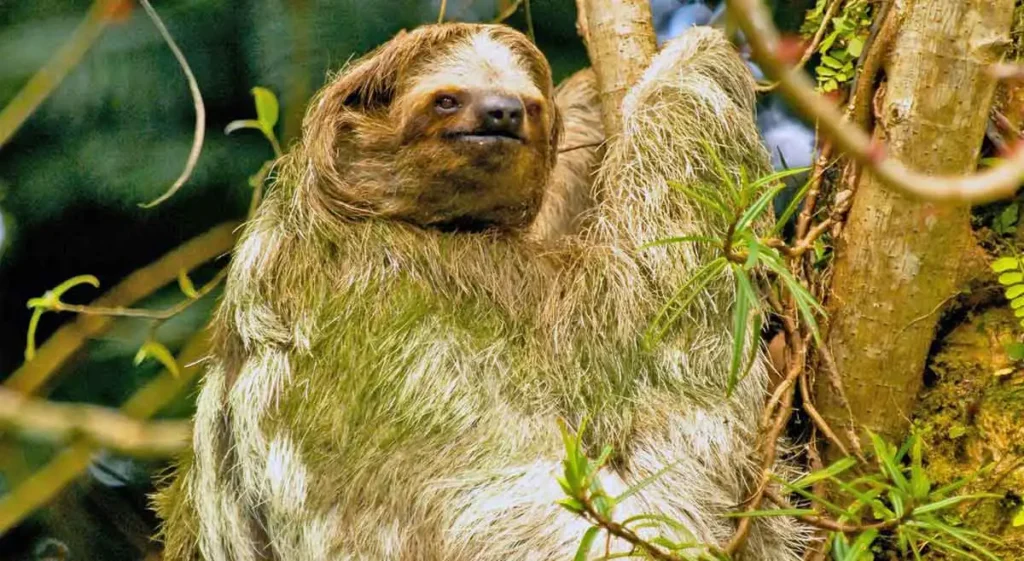 Pin
Pin Image by PetMojo.com
Sloths have a symbiotic relationship with algae. Their fur offers a conducive environment for algae growth, which provides them with camouflage. This greenish tint blends with the trees, making sloths harder to spot by predators.
Sloths, the unhurried darlings of the forest canopy, engage in a fascinating biological partnership with algae, showcasing one of nature’s most exquisite examples of symbiosis. This mutually beneficial relationship thrives within the unique environment of a sloth’s fur, which is specially adapted to foster algae growth, ultimately providing these gentle creatures with a natural form of camouflage.
The fur of a sloth isn’t just a protective outer layer; it’s an ecosystem within itself. Designed with grooves and a texture that readily collects moisture, sloth fur creates an ideal habitat for algae to flourish. This arrangement isn’t coincidental but a product of centuries of evolutionary adaptation, wherein sloths and algae have developed a relationship that significantly benefits both parties.
From the sloth’s perspective, the algae serve as an excellent camouflage mechanism. The dense forests and heavy canopies where sloths reside are draped in various shades of green, from the bright, vivid greens of new leaves to the darker hues of older foliage. The algae, which layer the sloth’s fur, dye it a green tint, allowing these slow-moving animals to blend seamlessly into their leafy surroundings. This natural disguise is crucial for their survival, as sloths are not known for their speed or agility. The greenish tinge of their fur makes them nearly invisible to predators like eagles and jaguars, who might otherwise spot them easily amidst the branches.
For the algae, the benefits are plentiful. The sloth’s fur offers not just a place to live but a moving feast of sorts. Sloths are known for their slow metabolism and low-energy lifestyle, which includes infrequent movements and long periods of rest. This sedentary existence means that the algae have a stable environment in which to grow, as well as access to sunlight as the sloths bask in the canopy’s breaks. Moreover, sloths descend to the ground to defecate about once a week, a behavior that further fertilizes the algae with necessary nutrients upon the sloth’s return to the trees.
This symbiotic relationship between sloths and algae is a vivid illustration of nature’s interconnectedness, where even the most unassuming partnerships can play a vital role in the survival of species. In the dense, green world of the tropical forest, the algae-covered fur of sloths is not just a quirky feature but a testament to the ingenuity of evolution and the delicate balance of ecosystems.
6. Limited Sleep
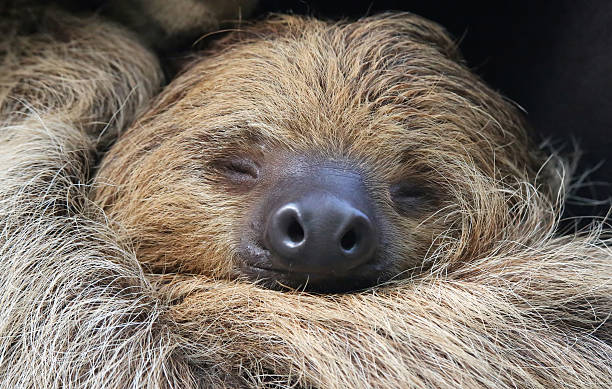 Pin
Pin Image by iStock.com
Contrary to popular belief, sloths do not sleep all day. Wild sloths sleep about 10 hours a day, much less than the 15-20 hours previously thought.
Contrary to the common misconception, sloths, the slow-moving arboreal mammals often associated with laziness, do not indulge in round-the-clock slumber. The public image of sloths as perpetual sleepers, dozing off for 15-20 hours a day, is far from accurate. Recent research has shed light on the true sleeping habits of sloths in their natural habitat, revealing findings that might surprise many.
In truth, wild sloths average around 10 hours of sleep per day, a figure significantly lower than previously believed. This discovery redefines the popular narrative around sloths and sleep, challenging the notion that sloths barely engage with the world due to their extensive sleeping patterns. Instead, it emerges that sloths might be more active and perhaps even more alert than popularly assumed, aligning their sleep patterns more closely with those of humans than with other long-sleeping animals.
This adjustment in sleep hours suggests that the sloth’s slow movements and leisurely lifestyle are not due to excessive sleep or lack of energy but are innate survival strategies. By moving slowly, sloths become less detectable to predators and conserve energy, which is crucial for their survival given their low-calorie diet of leaves. This behavioral strategy exemplifies the sloth’s adaptation to its environment, emphasizing efficiency and safety.
Correcting the misconception about sloths’ sleep habits also encourages a greater appreciation for their unique adaptations and lifestyle. It invites a deeper understanding of how seemingly simple aspects of an animal’s behavior can be misinterpreted and reminds us of the continuous need for direct observation and research in the natural world. By recognizing that sloths sleep less than we thought, we open the door to new questions and discoveries about these fascinating creatures and their roles in their ecosystems.
7. Solitary Nature
 Pin
Pin Image by Wikipedia
Sloths are solitary animals, coming together only during the mating season. After birth, the young sloths stay with their mothers for about six months, learning all they need to survive on their own.
Sloths epitomize a life of serene solitude, existing mostly in quiet isolation within the dense foliage of the tropical rainforests. These gentle creatures lead a solitary existence by design, their interactions with others of their kind limited predominantly to the necessities of reproduction. Mating season is the rare occasion that draws these solitary beings together, marking a brief period of social interaction before they once again embrace their solitary ways.
Upon the birth of their young, sloths demonstrate a deep, albeit temporary, shift in their solitary nature. Mother sloths take on a nurturing role, with the newborns clinging to their mothers’ fur for security and mobility. This period of maternal care is critical, lasting approximately six months. It is during this formative time that the young sloths learn essential skills for survival.
The knowledge imparted from mother to offspring encompasses a myriad of survival techniques, from foraging for food to navigating the complex network of branches that make up their arboreal home. This education also includes the art of camouflage, teaching the young how to blend seamlessly into the surrounding foliage to evade predators—a testament to the sloth’s keen adaptability and survival instincts.
Once this period of learning and growth concludes, the young sloths venture out on their own, equipped with the skills they need to thrive in the vast rainforest. They inherit a life of peaceful solitude, punctuated only by the cycles of mating and the eventual rearing of their offspring.
This cycle of solitary living, interspersed with brief episodes of togetherness, underscores the sloth’s adaptation to a life largely spent in isolation. Their existence, though quiet and unassuming, reveals a complex balance between solitude and the imperative of nurturing the next generation. Hence, the sloth serves as a remarkable exemplar of the beauty and resilience found in a life of solitude, interlaced with moments of profound connection and continuity within their species.
8. Endangered Status
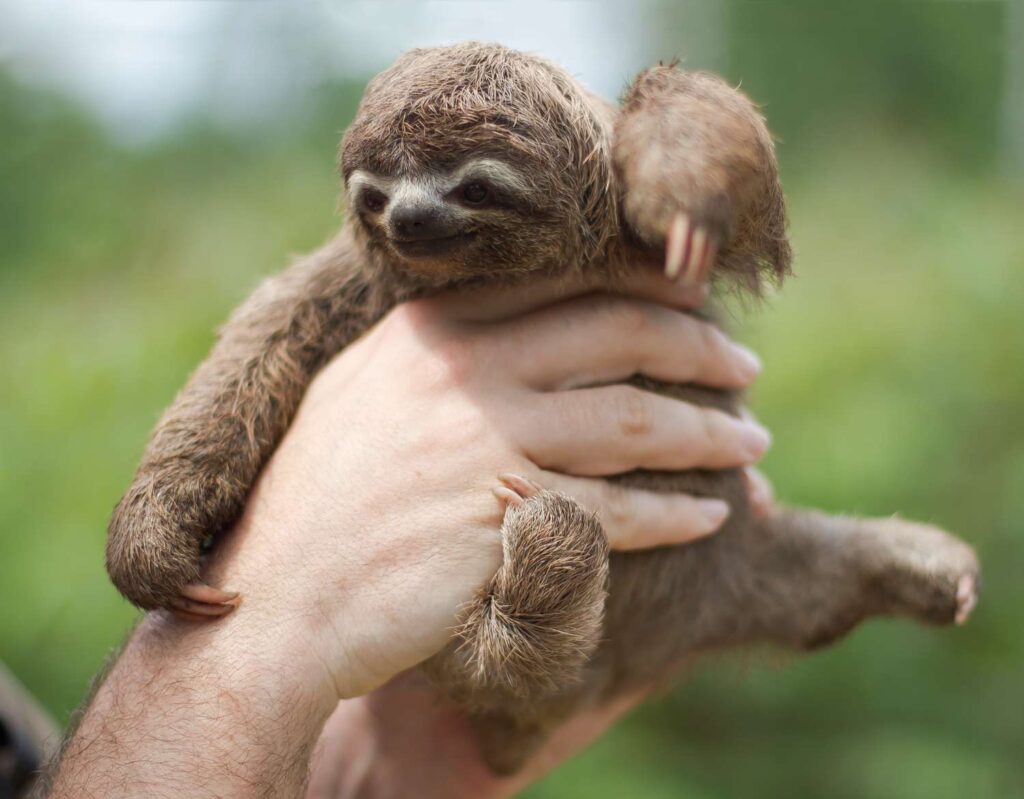 Pin
Pin Image by Treehugger
Some sloth species are at risk due to habitat destruction and climate change. Conservation efforts are essential to protect these unique creatures and their environment.
The delicate balance of our planet’s ecosystems is under constant threat, and few creatures epitomize the challenges of conservation as poignantly as sloths. These unique animals, known for their slow movements and peaceful demeanor, face urgent threats from human activities and environmental changes. The endangered status of some sloth species is a clarion call to action, highlighting the urgent need for conservation measures to safeguard these remarkable creatures and the habitats they call home.
Habitat destruction stands as a formidable challenge to the survival of sloths. Expansive deforestation for agriculture, urban development, and logging activities disrupts the intricate web of life in tropical rainforests, the natural home of sloths. This relentless encroachment not only deprives sloths of their food sources and nesting sites but also fragments their living spaces, making it increasingly difficult for them to find mates and reproduce. The resultant decline in sloth populations is a somber indicator of the broader ecological crisis afflicting biodiversity hotspots around the globe.
Climate change compounds these challenges, introducing additional stressors on sloth populations. Rising temperatures, shifting rainfall patterns, and increasing frequency of extreme weather events disrupt the delicate equilibrium of tropical ecosystems. For sloths, whose lives are intricately tied to the health of their arboreal habitats, these changes can spell disaster. Altered ecosystems may no longer support the flora that sloths rely on for sustenance, leading to malnutrition and decreased reproductive success.
The plight of these sloths underscores the imperative for concerted conservation efforts. Protecting sloth populations involves preserving the vast tracts of rainforest that are essential not only for sloths but also for countless other species that share their habitat. This requires international cooperation to enforce laws against illegal logging, poaching, and land conversion, alongside local and Indigenous community engagement to foster sustainable land management practices.
Addressing the root causes of climate change is crucial for the long-term survival of sloths and the ecosystems they inhabit. This means reducing greenhouse gas emissions, transitioning to renewable energy sources, and promoting conservation-friendly economic development initiatives.
In sum, the endangered status of some sloth species serves as a wake-up call, reminding us of the fragility of our natural world. By advancing conservation efforts and combatting habitat destruction and climate change, we can protect these unique creatures, ensuring that sloths continue to thrive in their ancient rainforest homes for generations to come.
9. Variety of Species
 Pin
Pin Image by animalspot.net
There are six species of sloths, divided into two categories: three-toed and two-toed. Each has distinct physical and behavioral traits but shares common fascinating features.
In the diverse and captivating realm of the animal kingdom, sloths stand out for their unique lifestyle and intriguing characteristics. Among these gentle creatures, there exists a fascinating diversity: six distinct species of sloths, bifurcated into two main categories based on the number of toes—three-toed and two-toed sloths. Each species under these categories boasts its own unique set of physical and behavioral traits, yet they all share some common, enchanting features that draw the curiosity and admiration of humans worldwide.
The three-toed sloths consist of the Brown-throated Sloth, the Maned Sloth, and the Pale-throated Sloth. They are primarily known for their more sociable nature and distinctive facial markings that give the appearance of a constant smile. These creatures possess a slightly different build and are often found in various parts of South and Central America, inhabiting dense rainforests where their green-tinted fur, thanks to the algae growing on it, aids in their camouflage among the lush foliage.
On the other side, the two-toed sloths include the Linnaeus’s Two-toed Sloth, the Hoffmann’s Two-toed Sloth, and the Pygmy Three-toed Sloth, which, despite its name, is often grouped with the two-toed varieties due to similar physical characteristics. These sloths tend to be slightly larger, have a more varied diet, and are less dependent on the forest than their three-toed counterparts. They can adapt to a more diverse array of habitats and display more nocturnal activity patterns.
Despite their differences, all sloth species share several captivating features. Their leisurely pace is iconic, a result of a low-metabolism adapted perfectly to their arboreal lifestyle, spending most of their life hanging upside down from tree branches. This slow movement, combined with their cryptic coloring, makes them nearly invisible to predators. Sloths have a symbiotic relationship with the algae that dwell in their fur, providing camouflage while the algae gain a place to grow.
These remarkable creatures encapsulate the beauty of nature’s diversity, each species a testament to evolutionary adaptation and specialization. As we delve deeper into understanding these uniquely fascinating animals, we uncover not only the intricacies of their existence but also gain insights into the broader ecological dynamics they are a part of.
10. Longevity
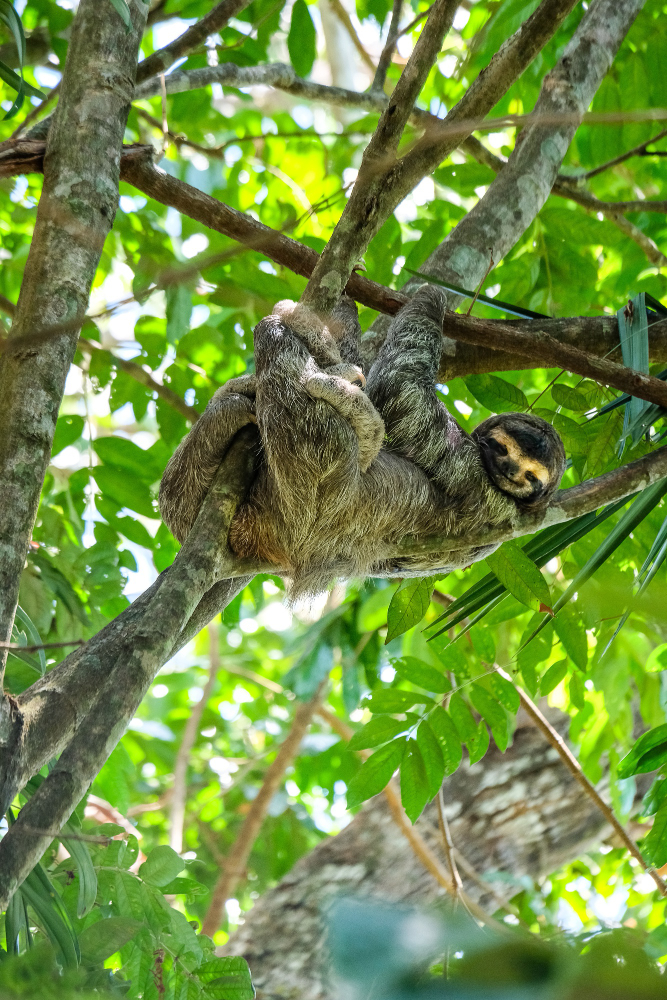 Pin
Pin Image by wirestock from Freepik
In the wild, sloths can live for about 20 to 30 years. Their slow metabolism and lifestyle help in reducing the wear and tear on their bodies, contributing to their longevity.
Sloths, those serene and languid creatures that dwell in the canopies of tropical rainforests, are well-known not only for their distinctively slow movements but also for their impressive lifespan. In the wild, these gentle animals can live for approximately 20 to 30 years, a testament to their resilient nature and adaptation to their environment. This notable longevity among sloths can be fundamentally attributed to their slow metabolism and their leisurely pace of life.
Unlike other mammals that lead more fast-paced lives, sloths have mastered the art of conservation. They utilize energy at a remarkably low rate, thanks in part to their slow metabolism, which limits their need for frequent food intake and allows them to subsist on a diet primarily composed of leaves. This leisurely lifestyle significantly reduces the wear and tear on their bodies that more active animals might experience.
Living atop the trees provides another layer of protection against potential predators, further enhancing their ability to live longer lives. By spending most of their time hanging from branches in a near-motionless state, sloths are remarkably adept at blending into their surroundings, making them difficult for predators to spot. This natural camouflage, paired with their habitat’s relative safety, minimizes the risks they face on a daily basis and contributes greatly to their longevity.
In examining the extraordinary lifespan of sloths, it becomes clear that their existence is finely tuned to the rhythms of their ecosystem. Their slow metabolism is not only a reflection of their dietary needs but also a brilliant adaptation to the challenges of their environment. By embracing a lifestyle defined by patience and minimalism, sloths have unlocked a key to longevity, teaching us the value of adaptation and the subtle strength that lies in taking life at a slower pace.
Sloths are much more than just slow movers. They are survivors, perfectly adapted to their environment with unique traits that continue to intrigue scientists and animal lovers alike. These ten facts only scratch the surface of what makes sloths truly fascinating creatures.
FAQs - Fascinating Facts About Sloths
There are six species of sloths, divided into two categories: three species of two-toed sloths and three species of three-toed sloths.
Sloths are famously slow, moving at a sluggish pace of about 2 to 3 meters per minute on the ground and slightly faster in trees.
Sloths are mainly herbivores, feeding on leaves, twigs, and some fruits. However, two-toed sloths have been known to eat insects and small prey as well.
Sloths have a slow metabolism to conserve energy since their diet of leaves provides very little nutritional value. This metabolism also contributes to their limited movement.
In the wild, sloths have a lifespan of about 20 to 30 years. In captivity, with proper care, they can live a bit longer.
Some sloth species are considered vulnerable or endangered due to habitat loss, poaching, and the pet trade. Conservation efforts are in place to protect these gentle creatures.
Yes, sloths are surprisingly good swimmers. They use a dog-paddle style and can hold their breath for up to 40 minutes underwater.
Sloths have specialized tendons in their claws that allow them to hang upside down with minimal effort. This position helps them blend in with the trees and avoid predators.
Sloths typically descend to the ground about once a week to defecate and urinate, making them vulnerable to predators.
Yes, sloths have natural predators, including jaguars, snakes, and eagles. Their slow movements and ground rituals make them susceptible to these predators.
Sloths have grooved fur that hosts symbiotic algae, giving them a greenish tint that helps camouflage them within the trees.





























